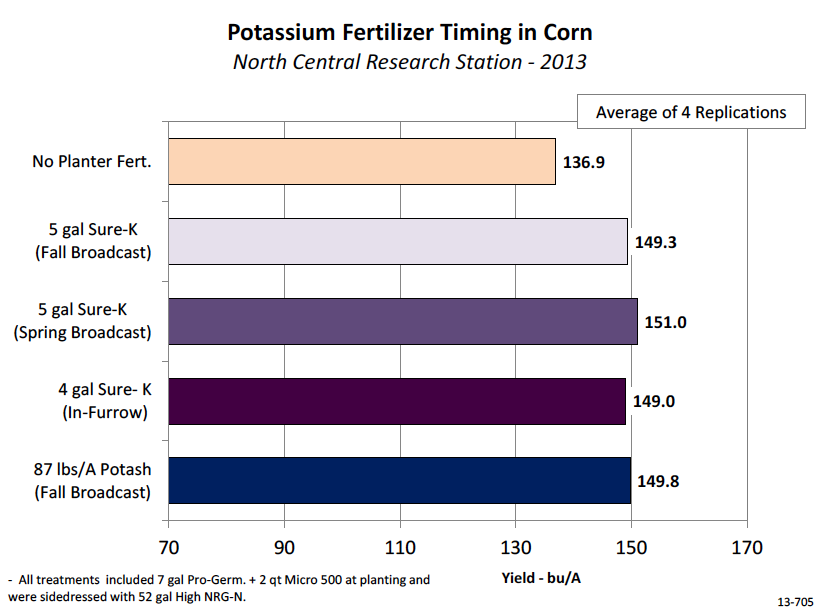[one_fourth style=””]
Experiment Info
Sidedress:6/9/2014
| Planted | 5/7/2013 |
| Variety: | DKC53-78 |
| Population: | 31,500 |
| Row Spacing: | 30 |
| Previous Crop: | Corn |
| Plot Size: | 15’ x 265’ |
| Replications: | 4 |
| Potash | 11/9/12 |
| PRE | 5/8 |
| Sidedress: | 6/8 |
| Harvested: | 10/15/13 |
Soil Test Values (ppm)
| pH | 6.9 |
| CEC | 9.5 |
| %OM | 2.1 |
| Bicarb P: | 10 |
| K | 112 |
| S | 7 |
| %K | 3.0 |
| %Mg | 19.5 |
| %Ca | 77.2 |
| %H | 0 |
| Zn | 1.5 |
| Mn | 10 |
| B | 0.5 |
| Yield Goal: | 175 bu |
| Target Fertilizer Rate: | 192-90-48 |
[/one_fourth]
[three_fourths_last style=””]
Objective:
To determine the optimum time for fertilizing a corn crop with potassium.
Agro-Culture Liquid Fertilizer’s Sure-K is seed safe to allow application of the required nutrients in-furrow when planting. Sometimes the question of when to apply potassium, if not with the planter, comes up. In determining to answer that question, a broadcast rate of Sure-K was applied in the fall. A comparison of fall broadcasted Potash was also applied. Both treatments were incorporated into the soil by chisel plowing the previous corn crop residue. The spring broadcast treatment of Sure-K was made and incorporated with a soil finisher before planting. Yield results appear in the table below.
Conclusions:
- The 4 gal/A rate of Sure-K gave nearly identical yields as the higher rate of Sure-K broadcasted or the dry Potash applications. The in-furrow placement puts nutrients where they are needed.
- Planter applied, fall or spring broadcast of potassium had no significant yield advantage to each other. The difference comes in the amount of nutrients applied to realize similar yields.
- In spite of these results, broadcast applications are not recommended at this time until more research is conducted.
- The no planter fertilizer treatment lacked the necessary nutrients needed to accomplish its yield potential.
- If Sure-K is going to be broadcast applied, a 20% increase in rate is needed to achieve comparable yields to planter applied rates.
[/three_fourths_last]


